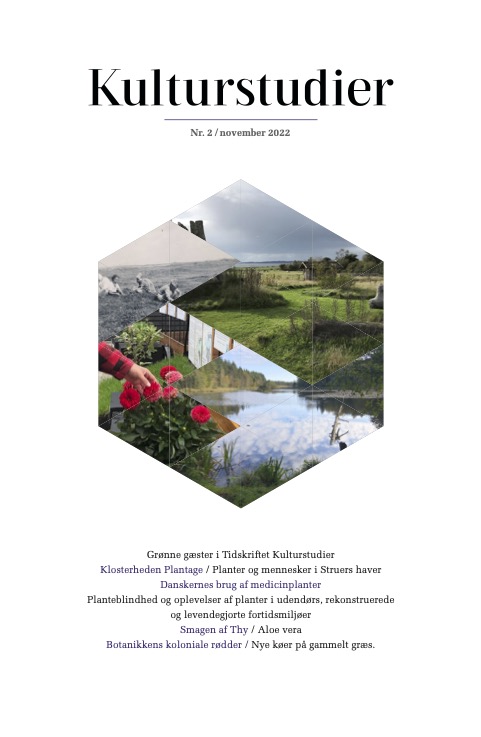Grønne gæster i Tidsskriftet Kulturstudier
DOI:
https://doi.org/10.7146/ks.v13i2.134657Resumé
I dette særnummer af Tidskriftet Kulturstudier har vi inviteret planter og plante- menneske relationer indenfor. Det gør vi for at markere, at vore levende, grønne medarter ikke blot er vigtige som objekter for natur og naturvidenskabelige studier, men fortjener lige så seriøs kulturvidenskabelig opmærksomhed. For planter er både natur og kultur. De har multiple ontologier.2 Det betyder, at planter er virkelige på flere forskellige måder – ligesom Jellingestenen er virkelig både som museumsgenstand, nationalt klenodie og som sten, afhængigt af hvilke sammenhænge den optræder i.
Referencer
Boyd, B. 2017: “Archaeology and Human–Animal Relations: Thinking Through Anthropocentrism”. Annual Review of Anthropology, 46(1), 299–316. https://doi.org/10.1146/ANNUREV-ANTHRO-102116-041346
Daly, L., French, K., Miller, T.L., Eoin, L.N. 2016: “Integrating Ontology into Ethnobotanical Research”. Journal of Ethnobiology 36(1), 1-9.
Daugbjerg, Mads 2022: ”Vold og volde i et stormfuldt landskab. Om krigens spor af beton langs den jyske vestkyst”. Kulturstudier 2022:1, s. 35-61. DOI: 10.7146/ks.v13i1.132889.
Fink, Hans 2003: ”Et mangfoldigt naturbegreb”. Naturens værdi: Vinkler på danskernes forhold til naturen. Gad.
Fuentes, A. 2010: “Naturalcultural encounters in Bali: Monkeys, temples, tourists, and ethnoprimatology”. Cultural anthropology, Vol. 25, Issue 4.
Gagliano, M. 2013: “Seeing Green: e Re-discovery of Plants and Nature’s Wisdom”. Societies 3, no. 1: 147–157.
Gjerløff, Anne Katrine 2012: ”Offer, Fjende, Frænde, Føde. Dyrs roller i Danmark i 1800-tallets slutning”. Historisk tidskrift 132:3, pp. 392-422
Haraway, Donna 2003: The Companion Species Manifesto: Dogs, People, and Significant Otherness. Chicago: Prickly Paradigm Press
Haraway, Donna 2008: When Species Meet. University of Minnesota Press. Hartigan, J. 2017: Care of the Species. Races of Corn and the Science of Plant
Diversity. University of Minnesota Press.
Ingold, Tim 2000: The Perception of the Environment. Essays in livelihood,
dwelling and skill. London: Routledge.
Ingold, Tim 2013: “Prospect”. I Tim Ingold og Gislí Pálsson (red.), Biosocial
Becoming: Integrating Social and Biological Anthropology. Cambridge
University Press.
Kean, Hilda and Howell, Philip (red) 2018: The Routledge Companion to Animal-Human History. London and New York. Routledge.
Kirksey, E. & Helmreich, S. 2010: “The emergence of multispecies ethnography.” Cultural Anthropology 25 (4): 545-576.
Kohn, Eduardo 2013: How forests think. Toward an Anthropology beyond the Human, Berkeley – Los Angeles, University of California Press.
van Dooren 2014, s. l.154.
Kolbert, E. 2015: The Sixth Extinction. An Unnatural History. Henry Holt and Company. United States and United Kingdom.
Lewis-Jones, K. E. 2016: “Introduction. People and Plants. World-making with Plants”. Environment and Society: Advances in Research 7, 1–7
Mol, Annemarie 1999: “Ontological politics. A word and some questions”. The Sociological Review. 1999: 47, s. 74-89.
Oma, Kristin Armstrong 2020: “On the Fringe. Sheepdogs and Their Status Within Bronze Age Ontologies in Scandinavia”. CURRENT SWEDISH ARCHAEOLOGY VOL. 28 2020 |
Onaga, Lisa. 2013: “Bombyx and Bugs in Meiji Japan: Toward a Multispecies History?” Scholar & Feminist Online 11, no. 3. http://sfonline.barnard.edu/ life-un-ltd-feminism-bioscience- race/bombyx-and-bugs-in-meiji-japan- toward-a-multispecies-history/.
Pálsson, G. 2013: “Ensembles of biosocial relations”. I Tim Ingold og Gislí Pálsson (red.), Biosocial Becoming: Integrating Social and Biological Anthropology. Cambridge University Press
Pilaar Birch, Suzanne E. (red.) 2018: Multispecies Archeology. London and New York. Routledge.
Rival, L. 2016: “Botanical Ontologies Special Section of the Journal of Ethnobiology Post-face”. Journal of Ethnobiology 36(1), 147-149.
Ryan, J.C. 2012: “Passive Flora? Reconsidering Nature’s Agency through Human-Plant Studies (HPS)”. Societies 2:101–21.
Simard, S.W. 2017: “The mother tree”. I Anna-Sophie Springer & Etienne Turpin (red),. The Word for World is Still Forest. K. Verlag and the Haus der Kulturen der Welt, Berlin
Thorsen, Liv Emma 2018: “Animal Matter in Museums”. I: Hilda Kean & Philip Howell (red.), The Routledge Companion to Animal-Human History. London: Routledge, 171–195. DOI: https://doi.org/10.4324/9780429468933-8.
Tsing, Anna 2015: The Mushroom at the End of the World: On the Possibility of Life in Capitalist Ruins. Princeton, NJ: Princeton University Press.
Tsing, A., Swanson, H., Gan, E. and Bubandt, N. (red) 2017: Arts of Living on a Damaged Planet: Ghosts and Monsters of the Anthropocene, Minnesota, University of Minnesota Press.
van Dooren, Thom. 2014: Flight Ways: Life and Loss at the Edge of Extinction. New York: Columbia University Press.
Viveiros de Castro, E. 2015: “Who is afraid of the ontological wolf?: Some comments on an ongoing anthropological debate”. The Cambridge journal of anthropology.
Wandersee, James og Schussler, Elizabeth 1999: ”Preventing plant blindness”. The American biology teacher.
Downloads
Publiceret
Citation/Eksport
Nummer
Sektion
Licens
Tidsskriftet forbeholder sig ret til førsteudgivelsen, mens ophavsretten til artiklen tilfalder forfatteren.
Artikler udgivet af Kulturstudier licenseret under en Creative Commons Navngivelse-IkkeKommerciel-IngenBearbejdelse 4.0 International Licens





